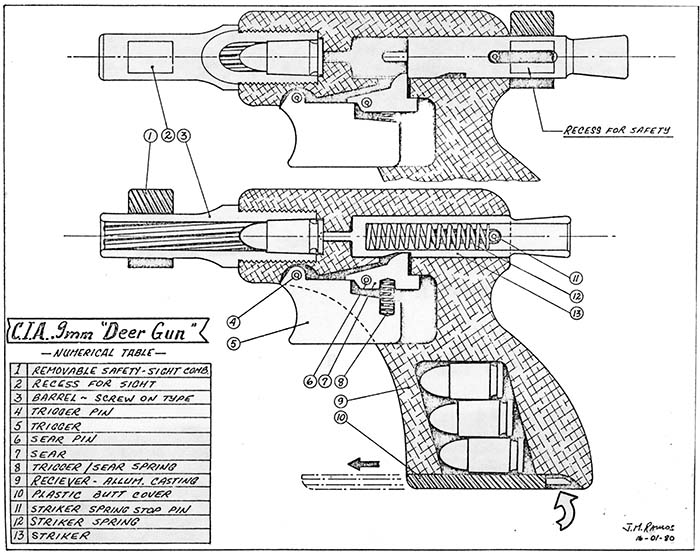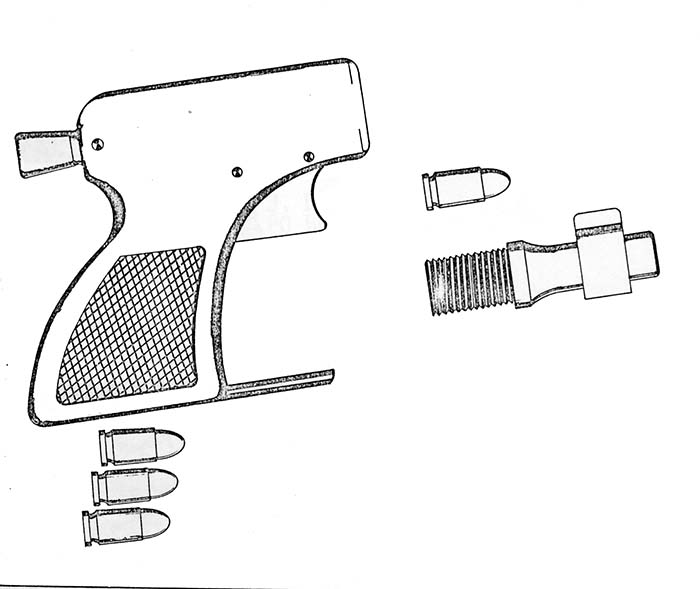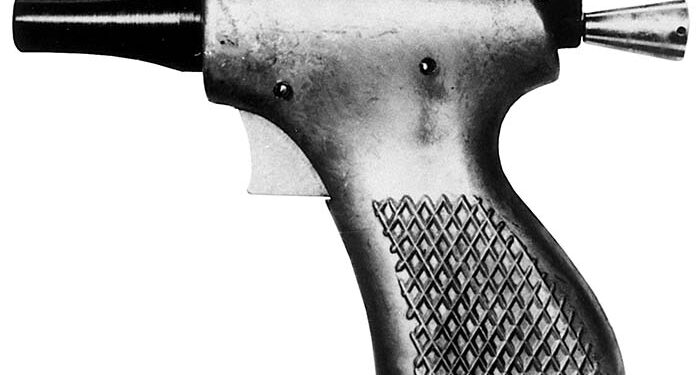By J. David Truby
Conceived as the Vietnam generation’s version of World War II’s Liberator pistol, the CIA Deer Gun was a simple, single shot 9mm pistol designed to bring better weapons to our partisans. The late major Dick Meadows, a U.S. Army Special Forces icon, explained the concept to me about 15 years ago.
“The idea was to supply these glorified zip guns to our friendlies who weren’t afraid to carry the war close and personal to the enemy. They’d get close, take him with the Deer Gun, then strip him of everything usable including his AK47”, “Meadows” explained.
This weapon’s genesis was discussed between military and CIA officials, plus several gun designers in the late 1950’s. The goal was a new version of the FP-45 Liberator, designed and produced by the thousands for the same lethal re-supply mission in World War II.
Why not simply re-issue the existing Liberators for Vietnam?
As Dick Meadows explained. “For the same insane reasons that other World War II material was destroyed in 1946/47. Liberator pistols were torched, melted and crushed into postwar scrap. Very few survived and there was no inventory by the time President Kennedy decided to support low profile, low intensity counter-guerrilla warfare in Vietnam.
“The true shame was that nearly a million of these little guns were cranked out in 1942/43 and certainly not all were lost in action or even issued,” Meadows added.
Research by Robert W. Koch documents that the FP-45’s were distributed by the U.S. military via the OSS in Europe, the Middle East and heavily into the CBI theater. Koch notes that nearly 30,000 were provided to the British for their SOE personnel. Gen. Douglas McArthur’s people requested 50,000 Liberators for supply in the Philippines.
Koch reported that one 1942 memo mentions the “desirability” of making up another million units. However, as the tactical nature of the war changed by 1943/44, it was clear the FP-45 would have a limited service life and no further orders were placed. Koch notes that nearly half of the original production never left arsenal storage.
However, by early 1962, with covert operations already hot in SE Asia, someone in Langley must have remembered those long-gone Liberators. That’s when CIA procurers met with the late Russell J. Moure, chief engineer for American Machine & Foundry’s special firearms division in Alexandria, VA. to plan the successor to World War II’s .45 caliber Liberator.
A legend in the paramilitary firearms business, Moure created the classic AMF military suppressor and other ordnance designs for that company and The Company. In addition to the Deer Gun, Russ Moure also designed the highly successful .308 drop-in conversion unit for the M1 rifle, as well as an 81mm semi-auto mortar for the Navy. He was also one of the pioneer developers involved in the mini-gun project.
When the CIA’s armament people met with Moure in 1962, the idea was to design a light, cheap “Liberator” style pistol. The government’s primary tenet for this new weapon was operational simplicity, while the second was that it be cheap and quick to build. The new pistol would supply indigenous guerrillas and irregular forces behind enemy lines.
One of his engineering colleagues at AMF said, “Russ spent 10,000 words explaining to some CIA guys what was basically a crude, ugly, but damn decent $4 zipgun for our Third World allies to kill one of the bad guy soldiers. Then, to take that guy’s weapon, probably an AK, for his own use. That was the CIA program for this weapon.”
Moure’s design was a tiny pistol with a cast aluminum receiver, a screw-out-to-load two inch barrel, plastic parts and budgeted to cost the U.S. $3.95 each. It was designed in 9mm, as that ammunition is far more ubiquitous than the .45 ACP of the World War II weapon.
This new pistol measured five inches in length, 4 1/8” high, 1 1/2” thick and weighed 12 ounces. It had a blued barrel and a bright aluminum handle/receiver unit. The grip was hollow to hold spare ammunition and an ejector rod to punch out the empty casing from the screw-off barrel.
According to ordnance legend Jack Kroma, a close friend of Moure, this was the lightest and smallest 9mm issue pistol ever developed, as well as being “of splendid design and robust construction.”
Jack Kroma also said that some of the Deer Guns were made with rifled barrels and some smoothbore, adding , “I saw quite a few of the Deer Guns when Russ was doing his work. Later, I saw six of the smoothbore models.”
The Deer Gun had no fixed sights and was fired by means of a cocking knob and trigger unit. The only safety was a plastic ring which slipped over the cocking knob, acting as a collar to physically prevent it from falling on the cartridge primer if the weapon were discharged accidentally. This collar also doubled as a front sight, to be slipped off the cocking knob and inserted on the barrel before firing.
After examining and testing Moure’s prototype, the Agency ordered 1000 pistols, issuing AMF a developmental contract for $300,000, quite a bit higher than the original price of under $4.00 per weapon.
These were developmental weapons which meant research and prototype costs had to be recovered. T. L. Smith, a former AMF official, who was on the Deer Gun project with Moure in 1962 explains. “The start-up costs were high, but, if we’d gone into mass production the projected figure of $3.95 could have been met easily”.
However, by 1964, it was evident that Southeast Asia was headed for major war status with clearly delineated covert parameters and rules of engagement which made the Deer Gun concept low priority.
However, the first run of 1000 pistols did go on active duty in totally deniable, sterile condition. There were no serial numbers, no ordnance proofs, no ID markings at all. Each Deer Gun was completely sterile, i.e., “sanitized”, as they say in spookspeak.
Each pistol came packed in a plain white polystyrene box along with three rounds of 9mm ammunition, also sterile, i.e., no headstamp markings. The box also contained a four-color, cartoon-style, wordless instruction sheet that in visual detail instructed the user how to operate the weapon and upon whom.
The cartoon instruction sheet depicted a generic guerrilla using a Deer Gun to shoot an enemy soldier who was wearing a Soviet arm and sickle armband. Ironically, that armband is the only identification marking of any kind found on the weapon, its container or the instructions.

Of the weapons delivered to the DIA, approximately 200 were sent to Southeast Asia for field testing, according to a consensus of sources. Although there is no official record that any were used beyond controlled, non-combat testing one U.S. military officer told me he accompanied a patrol of both U.S. and Vietnamese special forces in which two Deer Guns were carried for “active evaluation” as he put it.
The rest of his story is a tad grisly, but I have no reason to doubt the man’s word. I’ve known him and his honesty for nearly 40 years. Here’s what he told me.
“We had run a successful ambush and were returning for extraction with four prisoners, three of whom were wounded. The unwounded man resisted restraint. Because the potential for hostile reaction to us being there was very real, our senior man decided to terminate the recalcitrant prisoner.
That’s when I saw the Deer Gun ‘field-tested.’ One shot was fired from a range of three feet into the back of the base of the man’s head. He lurched forward and fell, quite dead. We then effected our extraction.”
By 1964, the Deer Gun was listed in the CIA’s special weapons inventory and carried a regular stock number, meaning it was cleared for field issue. That stock number was 1395-H00-9108.
Not much is known about this limited issue because the Agency has denied all FOIA requests for information about the Deer Gun. One case did make a very brief news splash in New York in 1975, when a robbery suspect was caught with what turned out to be a Deer Gun. He said he bought it on the street from some guy who claimed he’d brought it back from Vietnam. The pistol subsequently disappeared from the evidence locker.

There was also mention of an assassination of a Cuban official in Mexico City in 1970, reportedly with a Deer Gun, but, I could not document this.
I have seen only one mention of the Deer Gun specifically in a novel and that was in ONE POLICE PLAZA by the late William Cauntiz. In that fine fictional work published in 1985, Cauntiz names the Deer Gun specifically in a mysterious hit on “the second secretary of the Cuban Mission to the U.N.”
The story line has the hit done by CIA contract ops working to eradicate Castro’s intelligence people in the U.S. and Mexico using the Deer Gun, a very unlikely premise or choice of method or weapon.
Nonetheless, Cauntiz’s description and history of the Deer Gun is brief but generally accurate and the fictional anecdote does fit the factual reports of Deer Gun sightings. So does fiction mirror fact or vice versa?
When I tried to contact Mr. Cauntiz through his publisher, I was told that an interview would be impossible as Mr. Cauntiz is deceased.
There are a few more murky stories, possibly apocryphal about the Deer Gun. Jack Kroma adds with his usual curmudgeonly humor, “I have seen Deer Guns at two military museums and at a few research facilities. But, they must have grown legs and walked off, because they aren’t there anymore. Where did they go and who has them now?”
Of the original 1000 weapons, only 10 to 20 remain in circulation today according to collector Keith Melton. The majority were reportedly destroyed by government order. The rest seem to have just plain disappeared, meaning that they were “recovered” by individuals.
The post Vietnam history of the Deer Gun is no less mysterious than its highly unusual name. Several researchers and experienced military operations people have speculated on the origin of the Deer Gun name. Sgt. Gary Paul Johnston suggests that it is an Agency code name with sardonic reference to a survival weapon. Suppressor designer Don Walsh, a longtime friend of Russ Moure, thinks the weapon was named after a World War II OSS operation, the Deer Mission business in Burma. The genesis of the weapon name appears to be as mysterious as the ultimate fate of the weapons themselves.
Not so for the epilogue of its designer, Russ Moure. After AMF and the war years, he went to work for Firearms International as their chief engineer. Later, he joined Interarms as vice president of engineering. Russ Moure died during the winter of 1986/87 when he stopped to help a stranded female motorist near Washington. He was struck and killed by another vehicle, he was 65 years of age.
(Caution: the Deer Gun when encountered with a smooth bore barel is considered an NFA firearm requiring an registration under Title II as an AOW)
BIBLIOGRAPHY
Cauntiz, William. ONE POLICE PLAZA, NY: Banam Books, 1985
Koch, Robert W. THE FP-45 LIBERATOR PISTOL. Long Beach: Research, 1976.
Minnery, John A. and Joe Ramos. AMERICAN TOOLS OF INTRIGUE. Cornville, AZ: Desert Publications, 1980
Truby, J. David. ZIPS, PIPES, and PENS. Boulder: Paladin Press 1993
Personal interviews and correspondence with Jack Krcma, International Firearms Consultant; Joe Ramos, Firearms Designer; T.L. Smith, form AMF employee; Don Walsh, Weapons designer; John H. Wright, Central Intelligence Agency; plus former employees of Interarms, Inc. and American Machine & Foundry.
| This article first appeared in Small Arms Review V1N10 (July 1998) |











